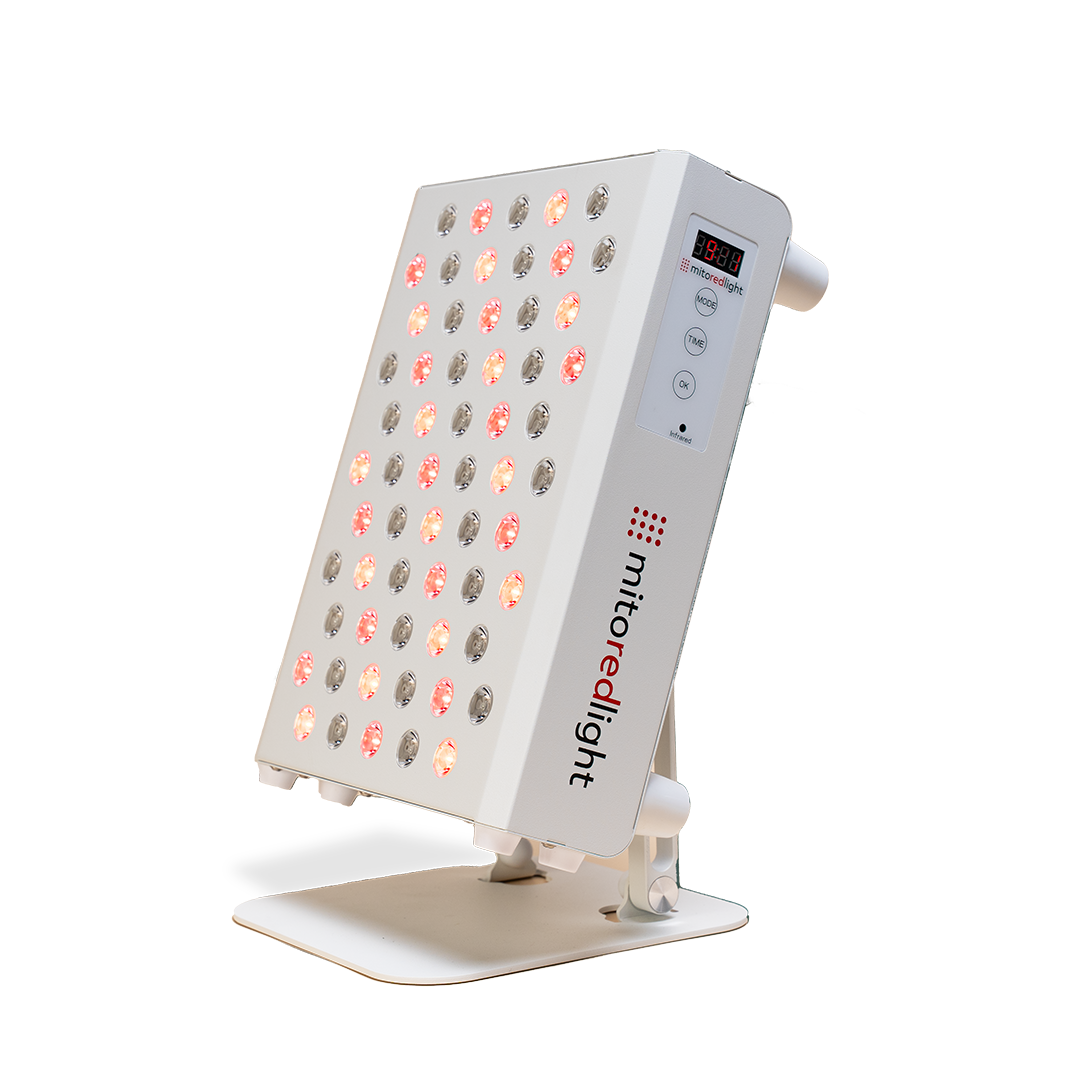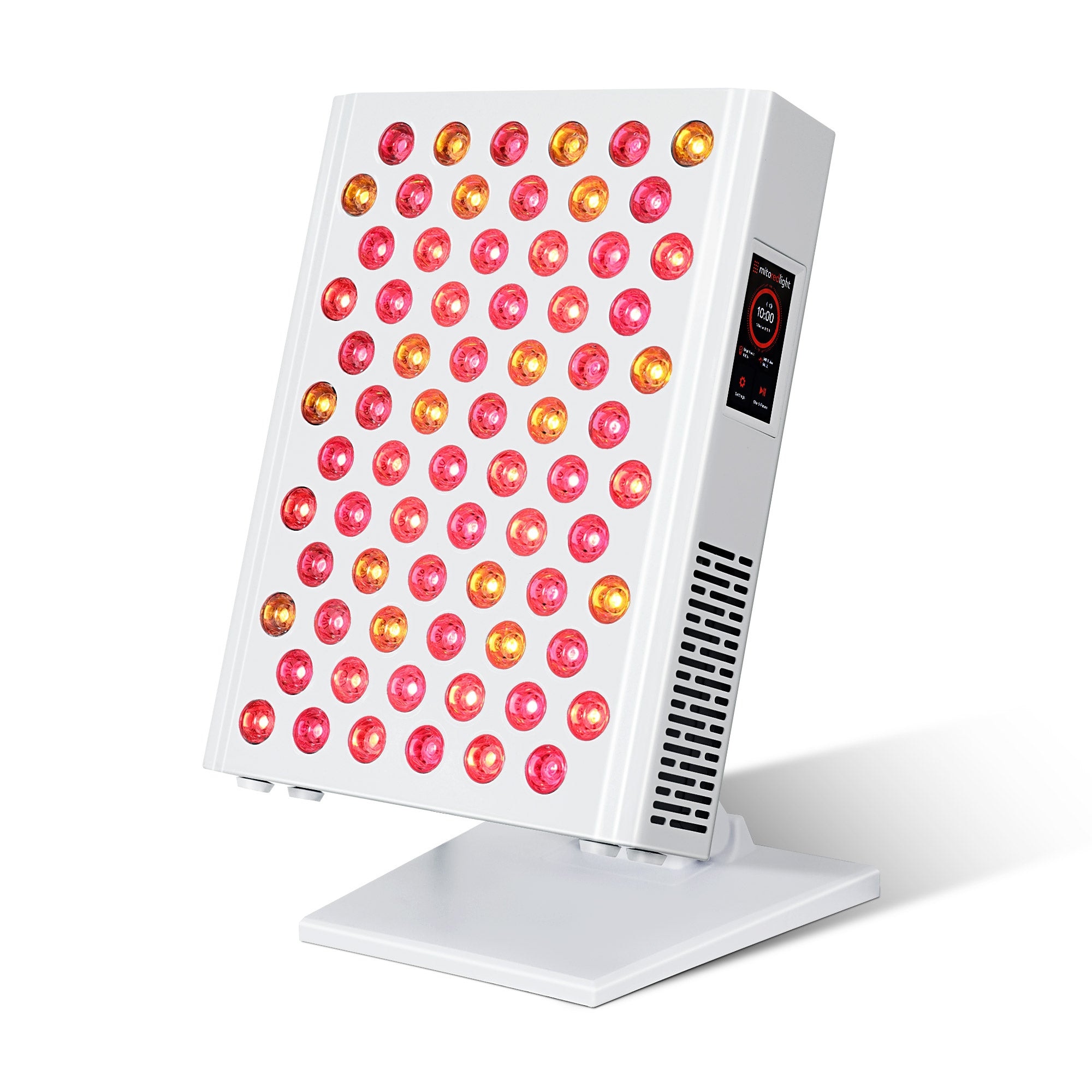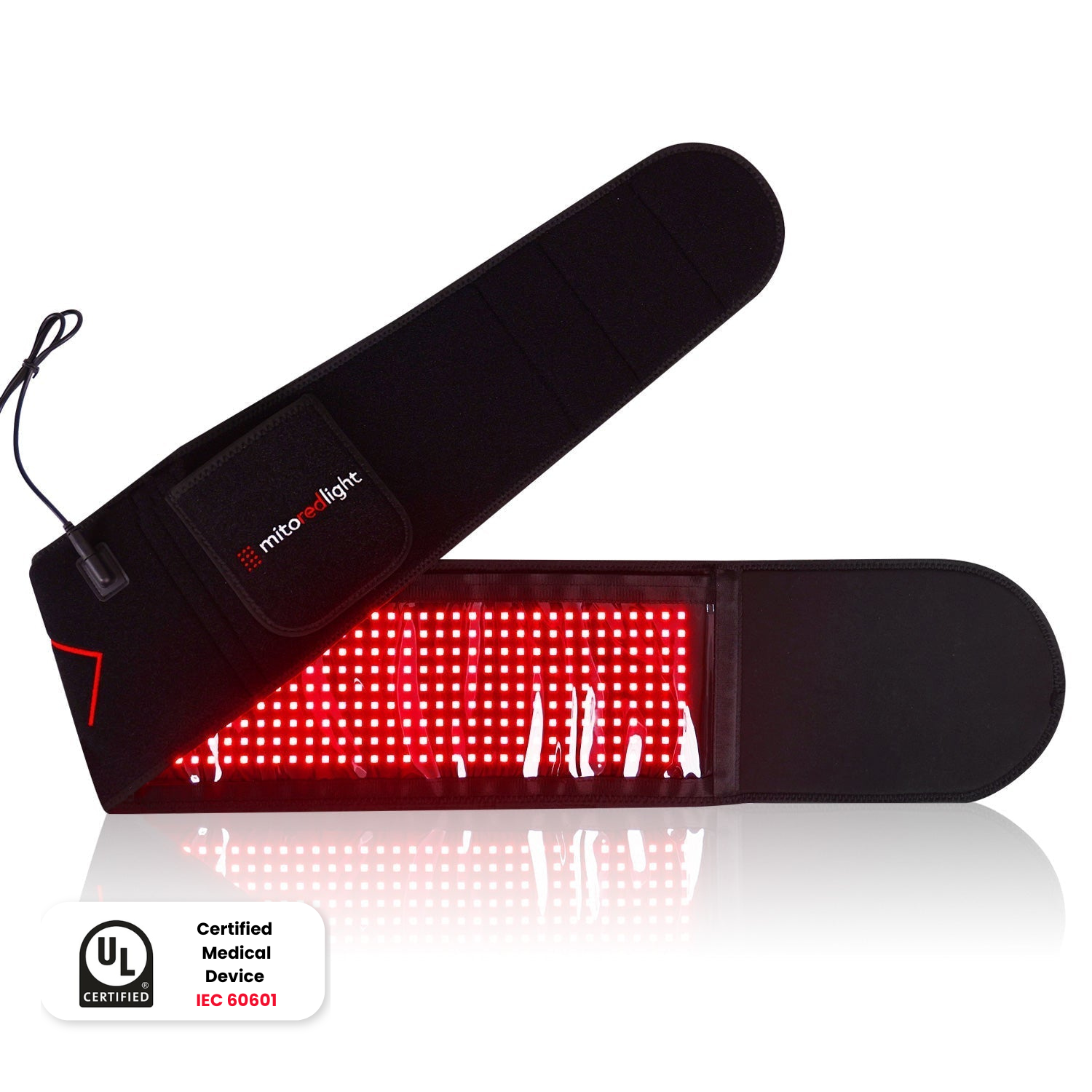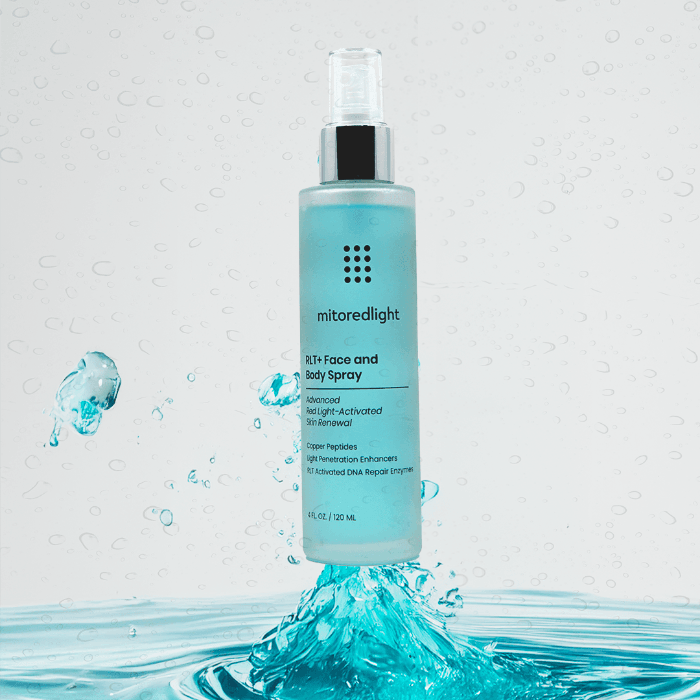DISCLAIMER: Mito Red Light devices are not clinically proven to diagnose, treat, cure, or prevent any medical conditions. Mito Red Light devices are low / risk general wellness devices aimed at affecting the body through supporting cellular function. The scientific studies referenced in this article are for educational and informational purposes only and are meant to educate the reader on the exciting and growing field of phototherapy. To see a list of precautionary warnings and contraindications, click here
Executive Summary
This Mito Red Light article explores red light therapy (RLT) as a potential solution for back pain, both acute and chronic. RLT, using specific light wavelengths (including near-infrared or NIR for deeper penetration), stimulates cellular mitochondria to produce more energy (ATP), promoting healing and reducing inflammation. For back pain, RLT may offer cellular stimulation and address the pain source. Common remedies for back pain include rest, physical therapy, and pain medication. To use RLT for back pain, start with short daily sessions (5-15 minutes) and adjust frequency as needed. Devices like panels and wearable belts (Mito Red Light Therapy Belt) can target the back. Mito Red Light emphasizes its high-quality, third-party tested devices with sufficient diode density and appropriate wavelengths for effective back pain relief.
Key Takeaways:
- Red light therapy may help manage both acute and chronic back pain.
- NIR light wavelengths are essential for reaching muscles and bones in the back.
- RLT potentially reduces inflammation and promotes healing at the source of back pain.
- At-home RLT devices like panels and wearable belts offer convenient back pain relief.
- Mito Red Light provides high-quality devices with appropriate wavelengths for effective back pain management.
Medically Reviewed by | Heidi Wright, BSN, RN, PCCN
There’s pain, and then there’s back pain. Whether you’re just joining the party or have dealt with on-and-off back pain for years, you know that when you have a flare-up, it can really knock you, well, on your back.
The usual remedies, heat, rest, and NSAID pain relievers, are all effective ways to alleviate symptoms, but if you’re concerned about unnecessary side effects of continued use of over-the-counter meds, want to add in complementary therapies, or simply want to take a more holistic approach, there is a solution.
Both research-backed and scientifically proven, red light therapy may be effective for those managing back pain, both acute and chronic in nature. We’ll talk about what it is, how it works, and how you can incorporate it into your routine to help with the reduction or management of back pain and help experience a more comfortable lifestyle.
What Exactly Is Red Light?
If it sounds a little sci-fi, that’s not too far off. Developed by NASA, red light therapy was originally used as a means of healing the wounds incurred by astronauts while they were in orbit. It was such a successful and useful tool that research around it expanded, and we now know it has even more benefits.
Both red light therapy and near-infrared light (NIR) light therapy use specific wavelengths of light to restore the body, rejuvenate the skin, and help promote healing and restoration for a myriad of health conditions.
How Does Red Light Therapy Work?
Red light therapy works by targeting your cells — the building blocks of your health. Inside our cells, tiny organelles called mitochondria work to produce ATP, a form of energy currency that the cells need to carry out cellular function.
When cells have plenty of ATP, they flourish. Flourishing cells have an upward domino effect that results in better-functioning tissues, organs, and entire bodily systems, which equates to a healthier, better-functioning body.
Red light specifically targets a portion of the ATP creation process that often becomes slower with age. By targeting this portion of the process, red light can effectively stimulate the mitochondria to make more ATP more efficiently.
How Might Red Light Benefit Back Pain?
There are different wavelengths of red light that are useful. To penetrate the skin and reach bone and muscle, however, you need near-infrared (NIR) light. This wavelength of light measures 800 nm to 900 nm.
Be aware that not all red light therapy devices offer this type of light, even if they are marketed as being effective in treating muscle soreness and joint pain.
The way red light therapy works for muscle and joint pain, including back pain, is twofold:
- Second, red light therapy may help address the source of the pain where it starts, promoting wound healing and reducing inflammation at the source.
Combining these two benefits results in a non-invasive, non-medicated approach to your back pain management routine that studies have shown to be highly effective with zero unwanted side effects.
What Should You Know About Back Pain?
Back pain can stem from numerous different sources, traumas, or genetic issues. If you suffer from chronic back pain, you probably have a good idea of the cause. From herniated discs to previous surgeries and injuries, your back is likely always slightly uncomfortable and may result in painful flare-ups if you move a certain way or perform a certain action.
Other types of back pain, known as acute back pain, occur less frequently. These issues usually stem from a low-level injury like a pull, a sprain, or repeated use. If you didn’t brace yourself properly for a deadlift, or if you simply slept on the wrong side, you could end up with acute pain that lasts for several weeks or even a month.
What Are Some Common Remedies for Back Pain?
The standard course of treatment for back pain and related issues is typically a physical exam if the pain is new, and possible diagnostic testing to rule out spinal injuries. You may have an MRI study taken to determine if any soft tissue or nerve damage is present.
Your healthcare provider will then give you a course of treatment that could involve the following.
Steroids
If you have serious inflammation in your back, a course of steroids or steroid shots might be recommended to help reduce swelling, treat pain, and help aid in recovery. Some people have success with steroids, while some experience unpleasant side effects that make them inaccessible as a treatment option.
Rest
Depending on the type of injury or pain you have, your doctor may prescribe a period of rest to allow your muscles to heal. During this time, it’s important to find out exactly what movements you should avoid and whether or not you should attempt any kind of physical therapy.
Physical Therapy
Often used after an accident or injury, physical therapy can help you regain movement if your back is stiff or if you have an injury that has healed. “Physical therapy is most successful when it is used consistently over time and the full course is completed to the end,” notes Heidi Wright, Registered Nurse.
Over-the-Counter Pain Meds
For acute pain relief, over-the-counter NSAID pain relievers and pain-relieving creams may be used. These are generally used for short-term relief and under the direction of a medical doctor.
How To Use Red Light Therapy for Back Pain
Red light therapy has been used to aid back pain management routines in patients to help them both modulate pain and help them return to their activities faster. Red light therapy stimulates blood flow to the site of the pain, helping keep the area oxygenated and reducing stiffness in joints and tightness in muscles.
Your healthcare provider may be able to offer you red light therapy sessions in the office, but if you have recurrent or chronic back pain, investing in your own at-home red light therapy device is more convenient and cost-effective.
In addition to aiding your pain management routine, red light therapy also may promote:
- Skin benefits
- Support for sleep
- Support for mood
- Support for muscle recovery and athletic performance
- Hair growth
By investing in a product to help with your back pain, you’ll also be doubling down by giving your entire body access to the benefits of red light.
To use red light therapy for your back, start with a 5-15-minute exposure period once per day. As your back becomes less sore, you can reduce your exposure to every other day or several times per week, leveling off on a maintenance or as-needed basis.
You can’t “overdose” on red light, and there is no harm to your body in more exposure, but there’s also no research that shows that additional exposure will give you increased benefits.
What Types of Red Light Devices Can You Use for Back Pain?
Not all red light therapy devices are created equally. Most have a limited number of diodes and lots of dead space that offer no therapy whatsoever. In addition, some devices, even red light devices in gyms and fitness centers, don’t offer the wavelengths of light necessary to reach deep into the body to the muscles and joints. While these devices do still offer benefits, if you are seeking the most relief from back pain, you’ll want a device that offers NIR light.
Panels
Red light therapy panels offer you the ability to treat a particular area of your body while you assume a comfortable seated position. Panels are movable and can be situated to target the area where you are experiencing the most discomfort.
Mito Red Light Panels are available in three different series, with a panel to fit your needs and give you access to the wavelengths you need.
Flexible Devices
Devices that are designed to be worn or wrapped around the body are known as flexible devices. Mito Red Light offers wearable red light therapy belts and mats that allow you to continue with your daily activities while you use them. For back pain, we recommend the Mito Red Light Therapy Belt, which gives you the ability to treat a sore lower back while you sit at a computer, read a book, or move around your home or office.
Mito Red Light devices are all third-party tested to ensure they are within the therapeutic range of benefit as defined by scientific research. All Mito Red Light devices feature the highest quality diodes, with more diodes per square inch than our competitors, so you don’t have to worry about dead space.
Get Relief Fast
Back pain can be a menace, but you can fight back with red light therapy. Red light therapy is quite safe and easy to use. The next time you “throw your back out,” reach for the red light and give it a try!
Sources:
NSAIDs (Nonsteroidal Anti-Inflammatory Drugs): Uses | Cleveland Clinic
Transcranial near-infrared light in treatment of neurodegenerative diseases | Frontiersin.org
The impact of wavelengths of LED light-therapy on endothelial cells | Scientific Reports

























